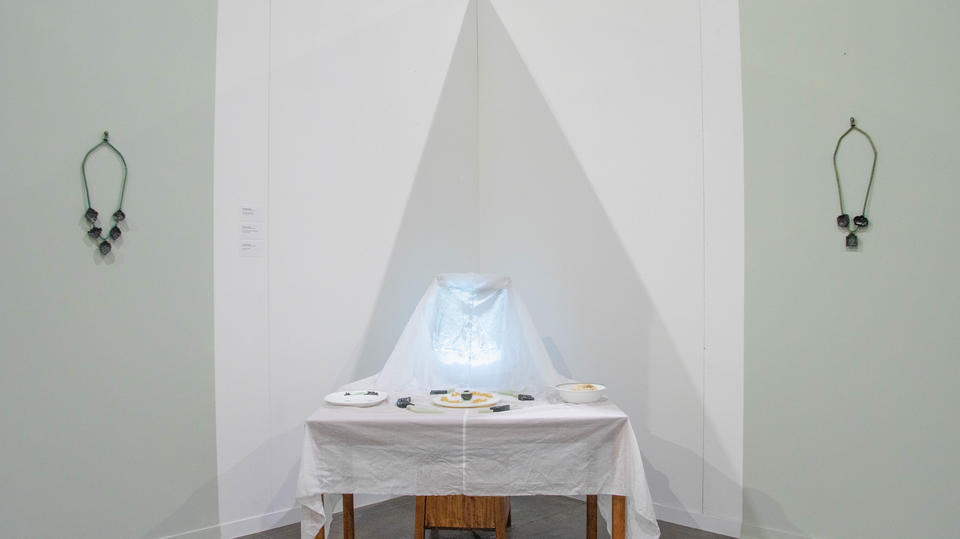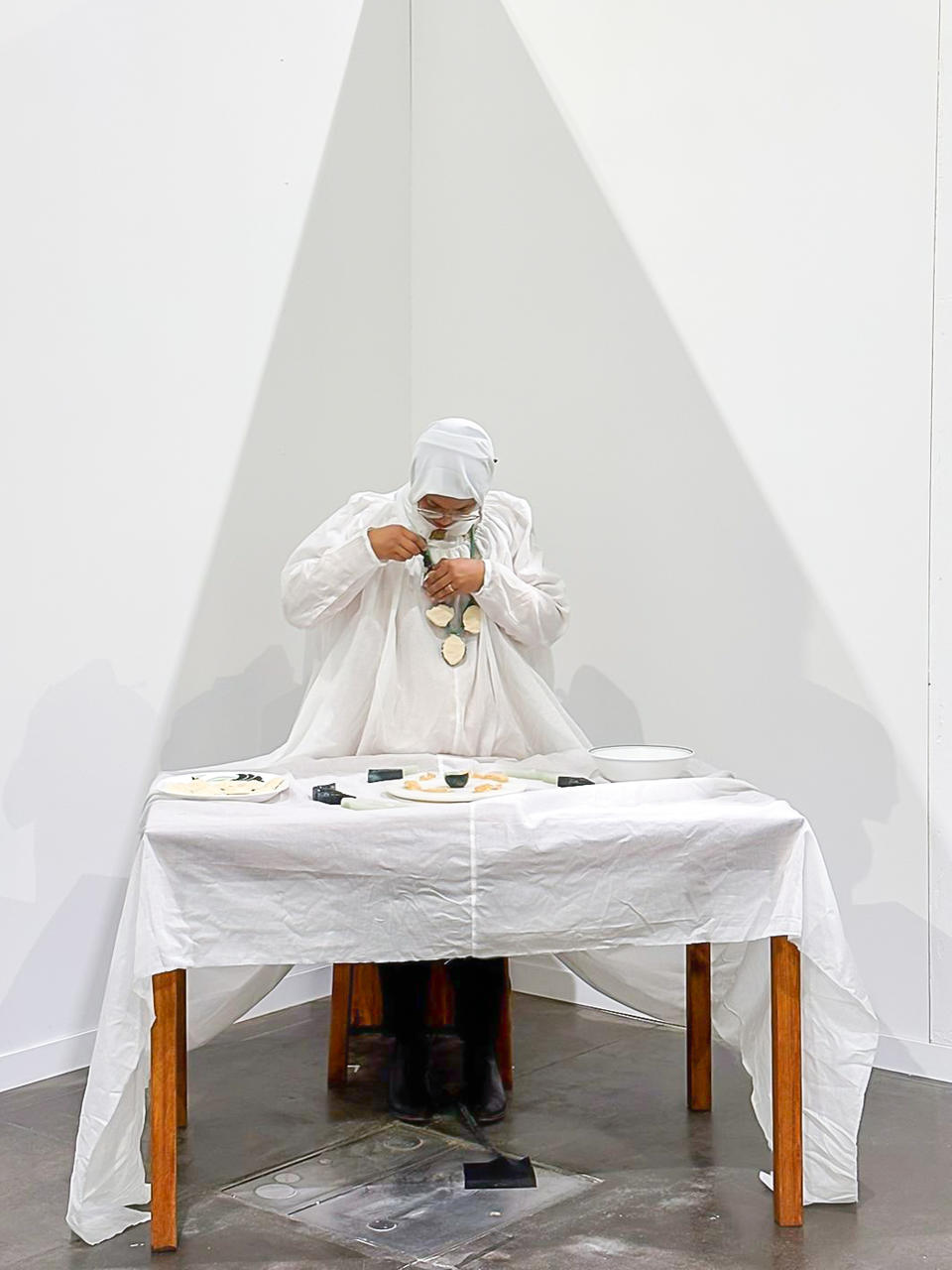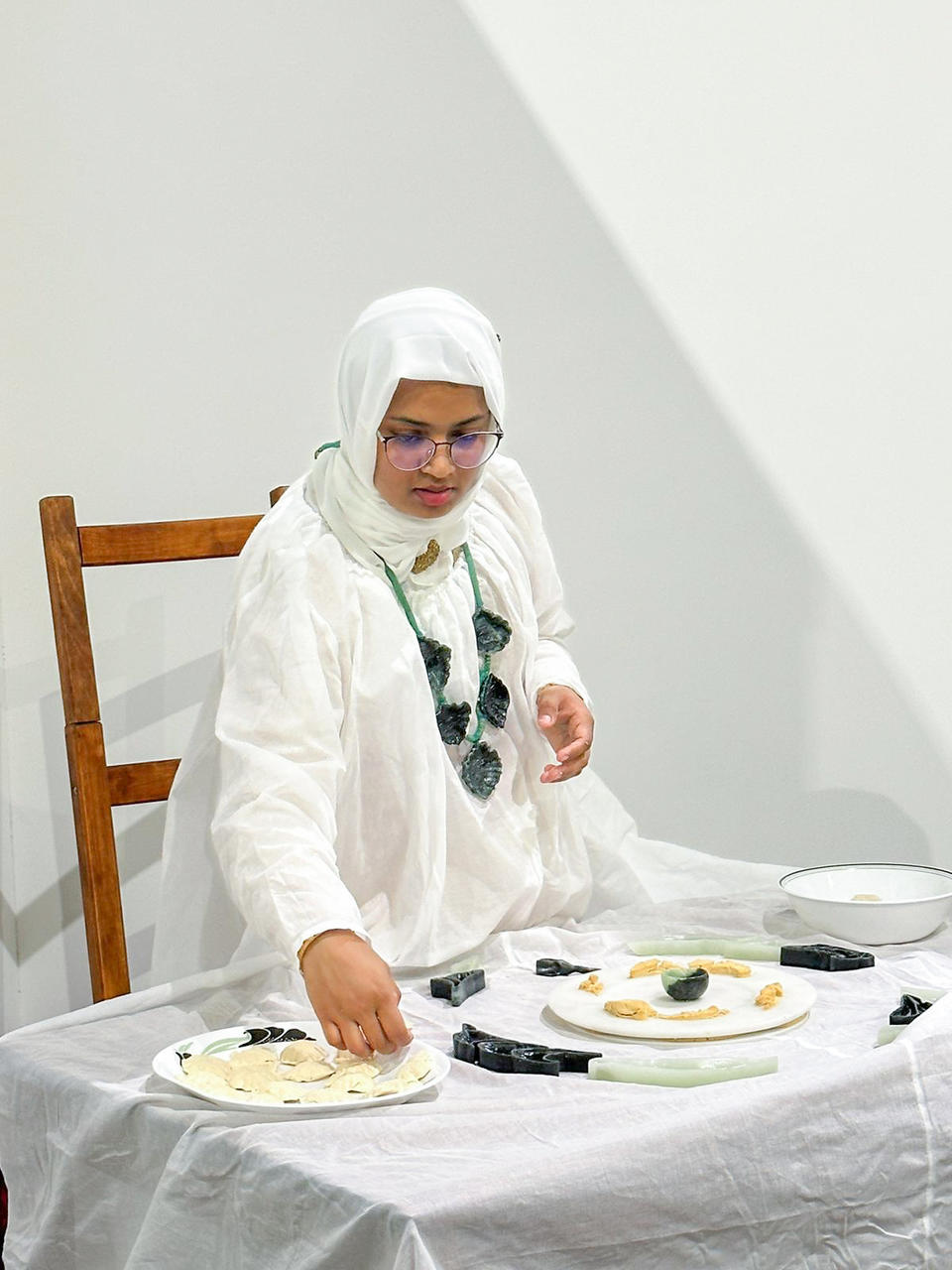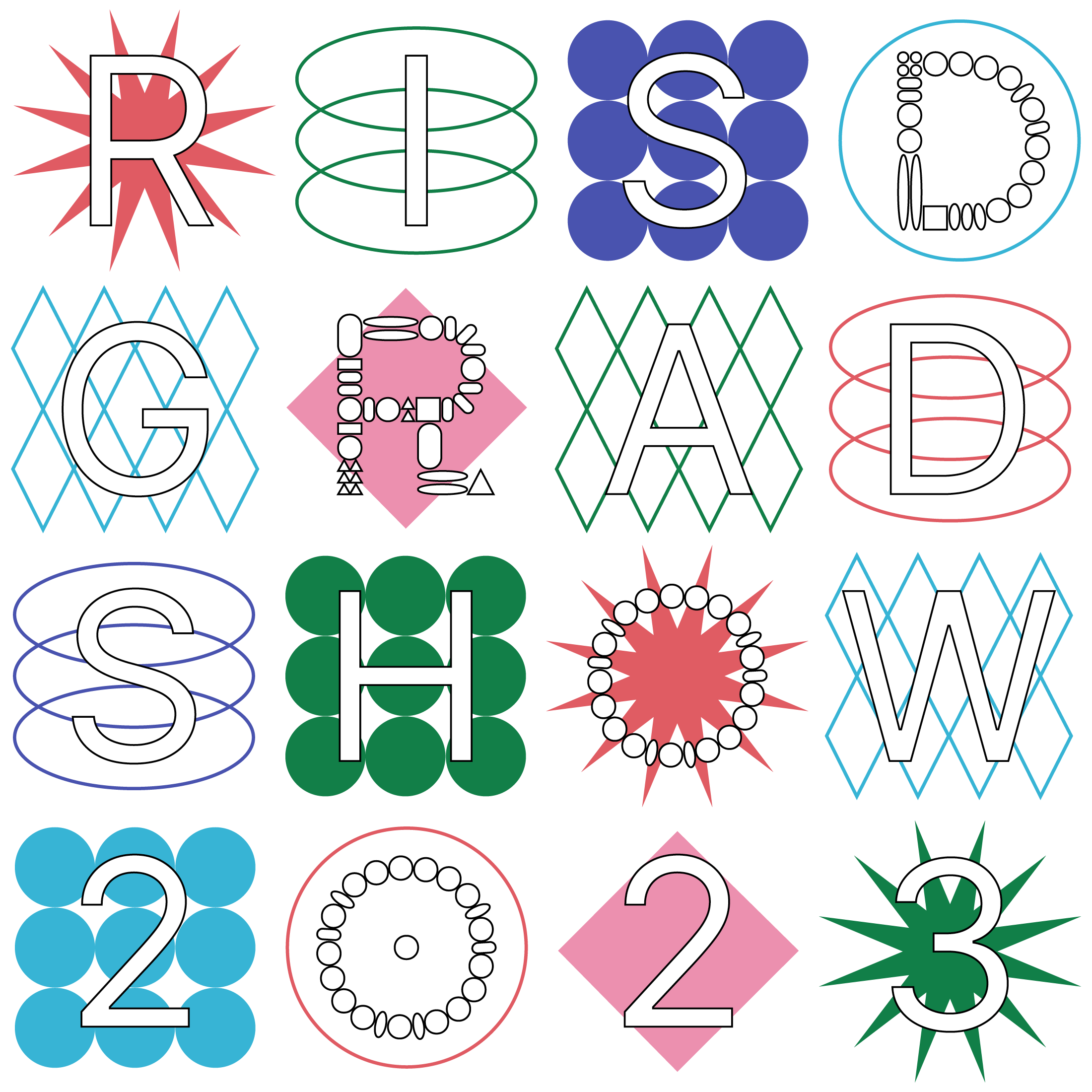Ayesha Mohyuddin
Luminous Eating
My work strives to reorient my gaze away from outward definitions of identity toward the complexities and nuances of experiencing the intersections of identity that comprise me and the space of home where I felt most extended. I do not want to essentialize the identifiers of Muslim, Bengali, and Tennessean, nor do I want to neglect the role memory and nostalgia play in shaping home as a place of expansion and ease. Food, cooking, and eating ground both nostalgia and identity in something physical. Through the sense of taste, I reorient myself to the inseparability of experience that cannot be contained by labels.
On Taste
Eating is intimate. By eating, you must expose the soft pink of your mouth. By eating, your body accepts the outside, the external, into the cavernous systems of the internal. That which you consume becomes your flesh. Becomes in-corp-orated. Substance alchemizes into the flesh of your being. Between the organs and nerves that comprise you, and the microbiology that inhabits you, food alchemizes into the body. Into being, Into you.
Colloquially, taste refers to the act of flavor perception. Flavor is inherently synesthetic [1]. Perceiving flavor involves both orthonasal and retronasal smell, taste, mouth-feel, mastication, swallowing, the sound of food between the teeth, the sound of the jaw, and the sight of the food itself. Flavor synthesizes these systems, collapsing even the distinction between senses into a single perception. Flavor perception utilizes an extensive portion of our brains, integrating primal brain functions of the brainstem with the orbitofrontal cortex of our brains where “higher” functions like judgment take place[2]. Flavor involves our entire beings, even though we perceive flavor as originating in the mouth.
Furthermore, flavor perception physically involves the memory systems of our brain. Smell is unique among the senses because it is directly linked to the brain's systems for memory and emotion [3]. Retronasal smell comprises much of flavor. The volatile particles from food in our mouths travel from the back of our throats to our olfactory receptors in our nasal cavity as we breathe in [4]. This is why food loses its “taste” with a congested nose. In this way, flavor can be seen as a way to physically perceive memory. Eating is a process of alchemy, a transmutation essential to life. It is not surprising that in the Sufi tradition of Ibn Arabi, knowledge of God is obtained through tasting: Dhawq [5]. Knowledge of the divine cannot be rationally explained or derived, nor can it be transmitted to another being. It can only be experienced directly, in all its sensorial complexities. The divine is only experienced, in whole, tasted with a flavor unique as the individual who does the tasting. There is no recipe for the divine, there is only taste. Sensory perception experienced. A taste that leads to a thirst that may guide a seeker mad until that thirst is quenched.
[1] Gordon M. Shepherd, Neurogastronomy: How the Brain Creates Flavor and Why It Matters (New York: Columbia University Press, 2012), 155.
[2] Ibid, 157.
[3] Ibid, 158.
[4] Ibid, 29.
[5] William C. Chittick, The Sufi Path of Knowledge Ibn Al-ʻArabi’s Metaphysics of Imagination (Albany, N.Y: State University of New York Press, 1989), 220.
Image
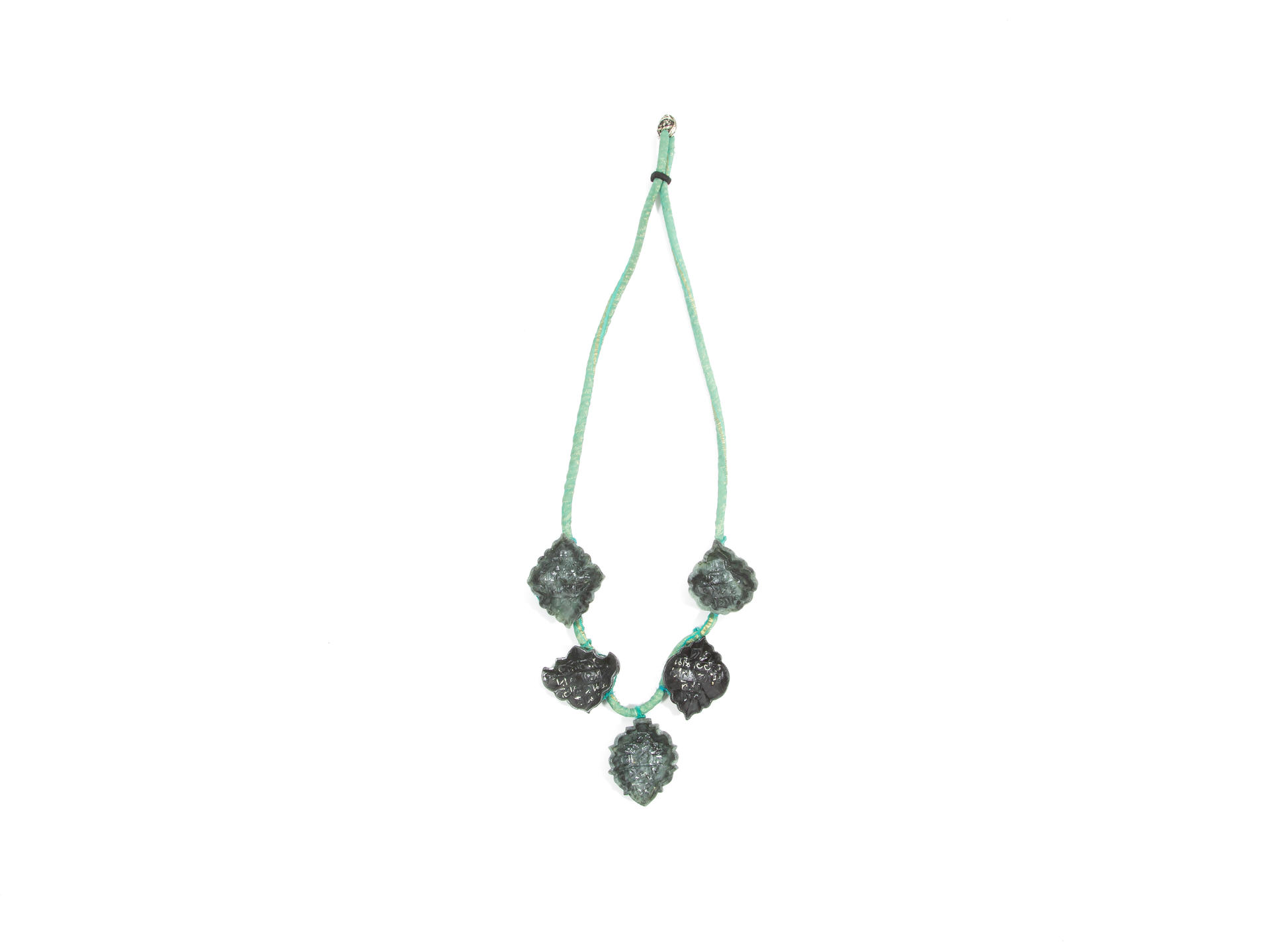
Untie the Knot From My Tongue, a necklace made of saree silk and shondesh molds carved from soapstone inscribed with the Bangla translation of the Quran verses “My Lord! Expand for me my breast, Make my task easy for me, and untie a knot from my tongue, so they may understand my speech!”
On Cooking
Anthropologist David Sutton writes about cooking as a skill. According to Sutton, the hallmark of true skill is that it is improvisational and adaptable, not re-creatable through instruction alone. Even written recipes act more as memory jogs rather than prescriptive instructions, as many recipes rely upon a basic understanding of the tools used in food preparation[6]. Cooking works similarly to flavor in that neither can be easily articulated without prior knowledge of embodied gestures and senses.
Yet, like jewelry taste, recipes, and the knowledge to prepare the food they prescribe are so often passed down through generations of women in the context of the kitchen. Both of my grandmothers made mishtis. “Mishti” is the word for “sweet” in Bangla, and is the general term used for desserts. The most famous desserts of Bengal are milk-based, and the mishtis my grandmothers, and later my mother, prepare are made by separating milk curd from whey with an acid. Roshogolla, roshomolai, and shondesh are made this way.
In other words, these mishtis entangle my mother and grandmother’s methods of making with my own memories generated through the physical act of making the sweet, the tools with which I remember making the sweets, the spaces where I remember the sweet, and the taste and scent of the sweet itself. These are personal and familiar legacies contained in the mishtis that I recall and re-inscribe by cooking myself. They are internal, formed by my direct experience.
Mishtis, especially the milk-based shondesh, are considered a quintessentially Bengali food. The fact most Bengali mishtis are prepared from separated milk makes them distinct from even other milk-based Indian sweets. Yet this Bengali dessert can be traced back to Portuguese traders in 15th century Bengal, who brought the technique of cheese-making into the region. Because of the specific socio-political conditions of the Bengal region among many other factors, Bengalis transformed this method into mishtis like shondesh. Shondesh, a Bengali dessert with roots in Portugal contains within its milky sweet morsel a deep history of trade, encounter, and conquest laced also with personal memories of family, home, and place.
[6] David Sutton, “Cooking Skills, the Senses, and Memory: The Fate of Practical Knowledge,” in Food and Culture: A Reader, eds. Carole Counihan, Penny Van Esterik, and Alice Julier (Routledge, 2018), 299-319, 310.
Image
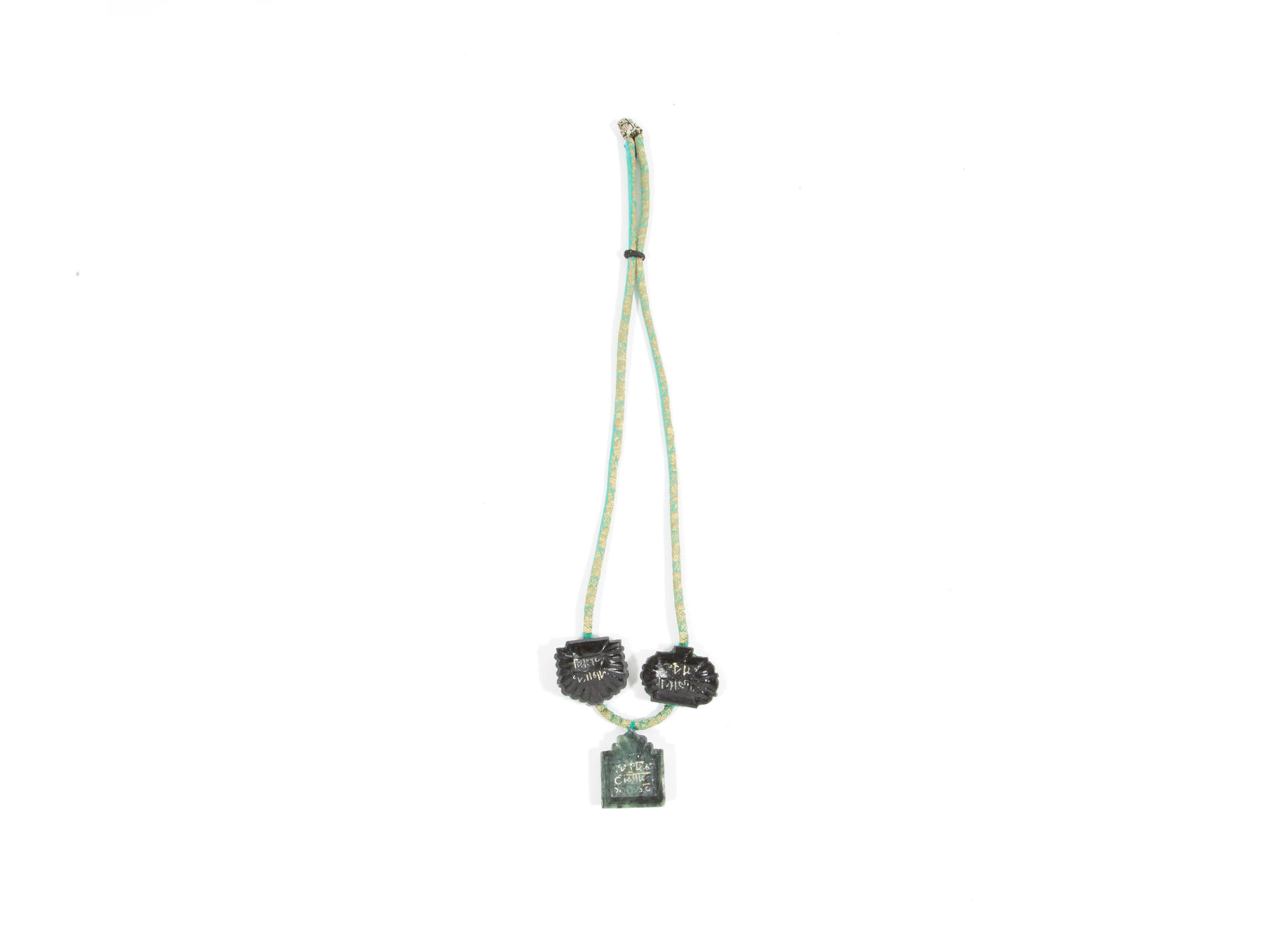
I’m Remembering, a necklace made of saree silk and shondesh molds carved from soapstone inscribed with the Bangla translation of the Quran verse “Remember Me, I will remember you.”
On tools
Kitchen tools carry family histories and multiple layered stories. [8] My mother’s kitchen tools have a history of their own. I’m drawn to the fact that many of her pots, pans, cooking spoons, mixing bowls, and tableware were either purchased or gifted early in my parent’s marriage, and therefore have been a staple fixture in my family’s kitchen and my memory of meals shared in that home. The design elements of these wares, as much as the foods eaten from them, have in turn morphed into the feeling of comfort and expansion of home.
When I first happened upon a Corelle brand plate with the Black Orchid pattern online, I felt a shock of recognition. I knew the graphic art deco black and green flowers and leaves from the 1990s-era tableware in my bones because ever since I could remember, my family ate from the same set of dishes. These plates are present in the old family photos and videos and recent pictures on my phone. They are so entangled with my memories of my mother’s care, the warmth of meals, and the kitchen as a space of participation. For me, the Corelle Black Orchid pattern is the pattern of home.
This pattern looms large in my memory. I carved each element of this graphic pattern into a small soapstone dish. When I arrange this set of small dishes together in a large circle, I can transform any surface into a Black Orchid Corelle plate. Through this pattern, I can extend the feelings of recognition, of security, of home, into a different environment. I can extend the very Corelle Black Orchid plate into my own surroundings.
If objects “afford” different possibilities of human use, the environment within which these objects live are not problems to which humans must adapt. Rather, objects constitute part of the total field of possible activity. [9] The space of my kitchen, the tools and technologies within it, its layout, decor, and scents all constitute the very real field of activity my body exists within when I cook. The built environment of my childhood kitchen and the objects within it, as well as my memories of my mother’s food, the way she moves about the kitchen, her relationship with spices, and her relationship to food, preparing meals, and eating all re-emerge through my experience of cooking.
If kitchen tools can extend possibilities, then carving my own shondesh molds propelled my mishti-making. I carved one simple mold that initiated my experiments with making shondesh in my kitchen. The tool activated the possibility to practice cooking this treat, which in turn served as a mnemonic device that brought forth my memories of this dessert.
I carved a set of shondesh molds from soapstone. Soapstone is the softest of stones, typically only one on the Mohs scale. Though it is a receptive, porous, and giving stone, soapstone is also dense and non-reactive. It retains heat and is a safe surface for food. Soapstone is forgiving. Instead of chipping away, I must only dig into the stone with wood carving tools to give it depth. The resulting residue is literally talcum powder.
By digging into stone to create a mold, I am reminded that what I perceive as lithified, stable, and opaque can even give way to repetition. The very carving tools that extend my body into the stone remind me that the stone itself does not have to remain solid. These soapstone pieces, most of which are mined in India or Brazil, allow me to carve away its matter. It guides my moves, sometimes breaking away where an internal fracture sits unnoticed.
[8] Sutton, “Cooking Skills, the Senses, and Memory,” 304.
[9] Ibid, 302.
Image
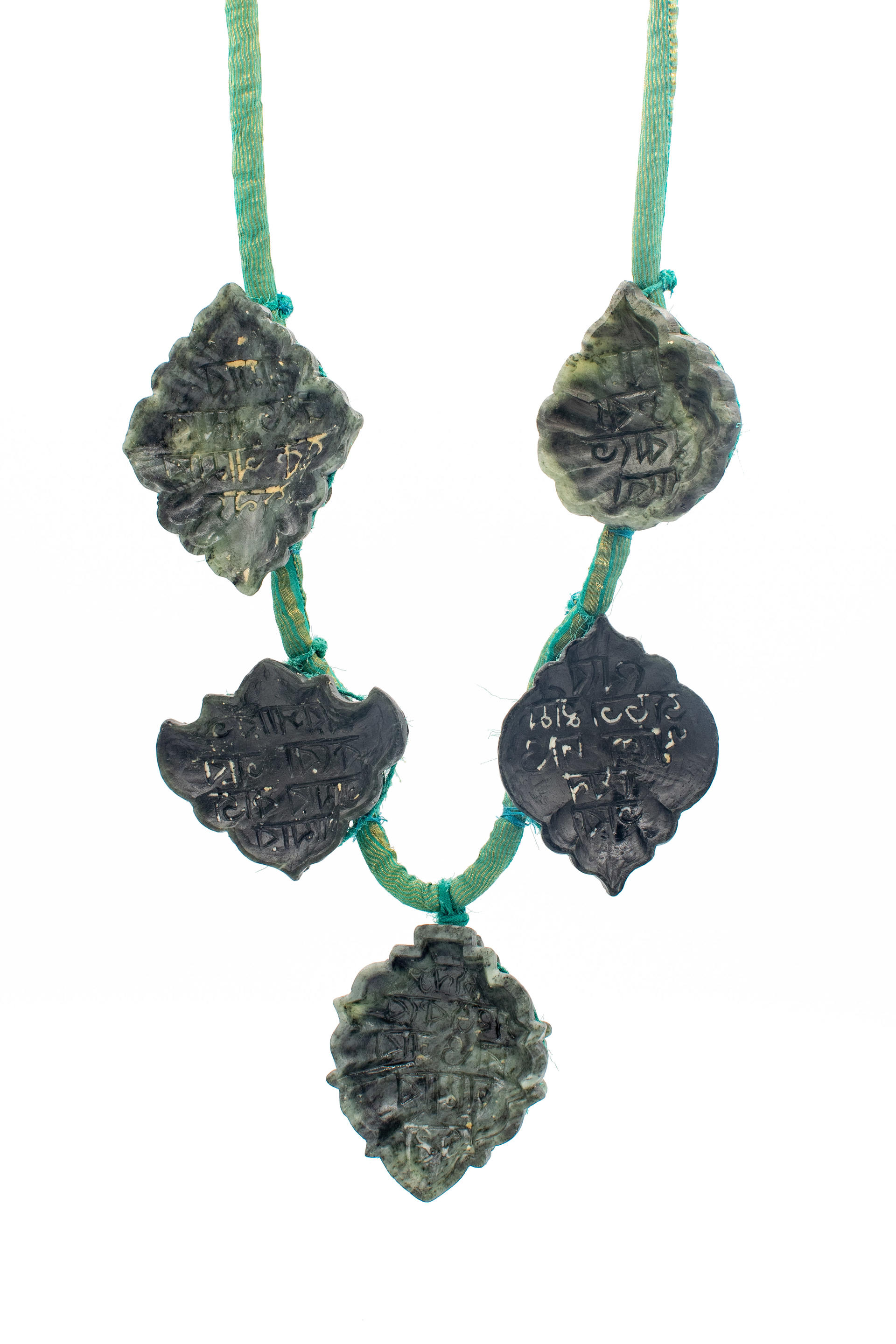
Detail of Untie the Knot From My Tongue, a necklace made of saree silk and shondesh molds carved from soapstone inscribed with the Bangla translation of the Quran verses “My Lord! Expand for me my breast, Make my task easy for me, and untie a knot from my tongue, so they may understand my speech!” Shondesh residue remains on the mold.
Inscribing
The Mughals, who established power in the Indian subcontinent in 1526 and conquered the Bengal Sultanate in 1576, also carved into stone. They carved marble, sandstone, emerald, spinel, jade, and more. Many precious and semi-precious stones were inscribed with Quranic verses in Arabic. These talismans could offer the wearer protection through the very physical presence of the text itself. I carve my soapstone shondesh molds into the shape of many of these talismans.
He said, “My Lord! Expand for me my breast / Make my task easy for me / and untie a knot from my tongue / so they may understand my speech! Quran 20: 25-28
I habitually say these verses in Arabic before a discussion or presentation as a prayer to communicate clearly. How do I begin to communicate the expansive feeling of my home when I feel limited by the labels that are supposed to correspond to that experience? How do I acknowledge my inseparability from the histories carried with my family and within the place I call home? Sara Ahmed writes, “home as over flowing and flowing over.” [10] One feels extended when one is at home.
The prayer “expand for me my chest” implies that the supplicant feels a sense of constriction. A tightness in the chest, a heaviness of the heart that constrains, or that squeezes the ability to articulate. These verses are a prayer for expansion, clarity, and receptivity. This prayer is a plea for that feeling of extension.
I know these verses in Arabic and in English. But in the process of inscribing the Bangla translation of these verses into the soapstone molds, I had to trace and retrace letters I did not know that correspond to sounds that my tongue and ears are familiar with. In the process of carving the prayer, I am learning Bangla through the Quran.
This act of carving Bangla text becomes a reciprocal act, a production that is re-embodied. This action of carving reciprocates by teaching me the language. Carving is an act of learning that allows me to re-remember. Bangla as a language, Bangla as the Quran, and Bangla as an expression of my own Muslimness. Carving the verses I am so familiar with in a language that is familiar yet not well known to me becomes reciprocal. By carving in Bangla, I am untangling the knot on my tongue by learning, practicing, and inscribing the Bangla letters. In the act of carving, I am answering the prayer.
“So Remember Me, I will Remember You.” – Quran 2: 152
The act of remembrance itself is reciprocal. To remember is to conjure something removed in either time or space, something out of reach, into the present moment. Remembering makes that which is being remembered immanent. The Quran verse above highlights the reciprocal relationship inherent in remembering the divine, that in the very act of remembering the divine, the divine remembers you back.
I carved this verse into a second set of soapstone shondesh molds. This verse, too, I translated into Bangla, learning the letters and the sounds they hold, new yet familiar, as I carved them into the stone. The reciprocal nature of the verse feels more intimate to me in Bangla than Arabic somehow since these Bangla words are ones I already understand. I receive another layer of meaning through that translation.
This sense of reciprocity, that doing conjures meaning, is something that feels deeply connected to food and cooking. It is present in the question that encircles this work, and many of the foods I choose to eat generally: if I cook and eat Bengali food, will I become more Bengali? Is it possible to reinforce a Bengali identity through eating and food preparation without essentializing that identity, and therefore protect this heritage from loss as time moves on?
[10] Sara Ahmed, Queer Phenomenology, 11.
Image
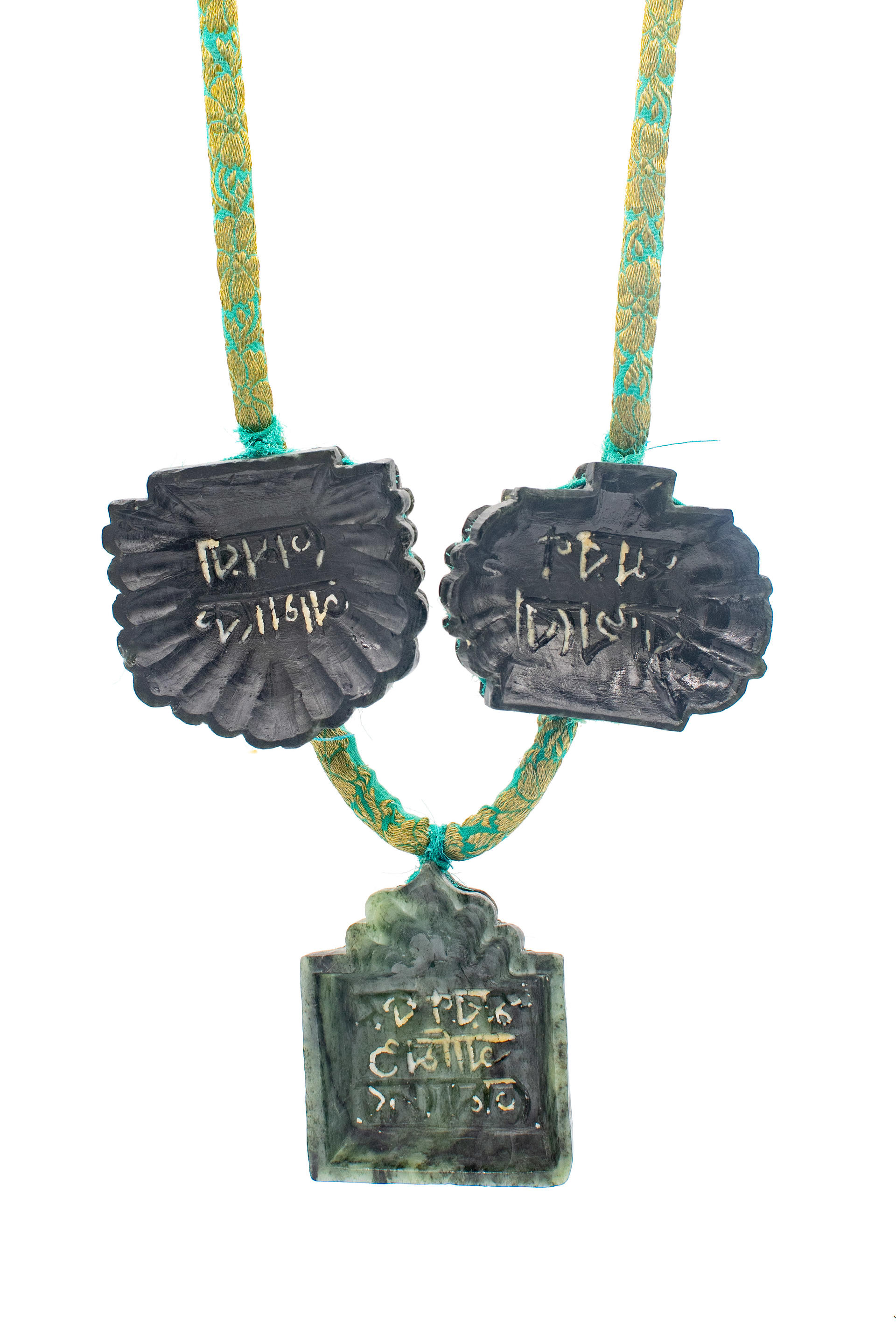
Detail of I’m Remembering, a necklace made of saree silk and shondesh molds carved from soapstone inscribed with the Bangla translation of the Quran verses “My Lord! Expand for me my breast, Make my task easy for me, and untie a knot from my tongue, so they may understand my speech!” Shondesh residue remains on the mold.
Molding
Sutton writes that cooking sits between production and consumption. [11] The embodied tasks carried out and the transformation that occurs all contribute to an edible end result that is meant to be consumed. Internalized. Ingested. To be successful, the result of cooking must inevitably disappear. Yet the effects of cooking remain legible within the tools and smells and residues that remain.
The necklace sits on my chest, conforming to the softness of my body. Like cooking, jewelry inhabits an in-between space. Jewelry enfolds the body without becoming it. Jewelry can encircle a wrist, embrace a chest, or even pierce through an ear, but it is never fully internalized. Until the stone molds of my necklaces are used, they are not activated. The verses inscribed in each mold are not even legible. All of the text is mirrored, hinting that, as a necklace, the mold itself is incomplete. To be legible, something must be impressed into the stone. Like cooking, this necklace sits between production and consumption. Unless I make mishti these necklaces will remain unactivated, their potential not yet realized.
So I make shondesh. I emphasize my own contingency in making my mishti by becoming part of the environment wherein I make. Through a flowy garment of white cotton voile, the most accessible fabric I imagine the lost art of Dhakai muslin to resemble, I am draped over the kitchen table. This cotton garment is the tablecloth, and I become embedded within the kitchen.
Covered in this garment that extends me from the dining table, I wear the necklace. I scoop a chunk of shondesh, soften it in my hands, and press it against my chest, into the stone molds of my necklace. I press against my chest, a gesture of depth, of pain, of closeness, a gesture to understand my own brown body, my own Bengaliness, my own Muslimness. This act of molding against my chest is my prayer for “an expanded heart,” for “an untied tongue.” It is an embrace of the women who have given me so much, and a recognition of my inseparability.
With each pressing, I also relax. With a carved tool, I release the morsel of shondesh from its mold and place it on a plate. As the plate fills, the entirety of the verses becomes legible, but in the form of food. In the form of a quintessentially Bengali dessert that contains the complex histories of encounter and land and my own family and identity in one sugary sweet bite.
Ultimately, the necklaces are the means for something temporal. The necklaces and the ritual of molding beckon me to remember that I am remembering. The necklace sits upon my body. The garment sits upon my body. The labels I struggle to understand my relationship with, Bengali, Muslim, Tennessean, etc., also sit upon my body. But the molded shondesh is meant to be eaten. It is supposed to be tasted. It asks to be sunk between one’s teeth, activating the sweet and slightly tart taste buds on the tongue, coating our mouths with its fattiness, only to be swallowed a moment later. Maybe for some, that taste also activates memory and nostalgia; for others, it is a new experience; still for others, an unpleasant one. But in every case, shondesh is made to be ingested. Digested until its nutrients become you. Masticated so that the prayer embossed inheres into your very body. Internalized so that its history remains physically with you. And yet eventually, what is left will be expelled.
[11] Sutton, “Cooking Skills, the Senses, and Memory,” 300.
Image
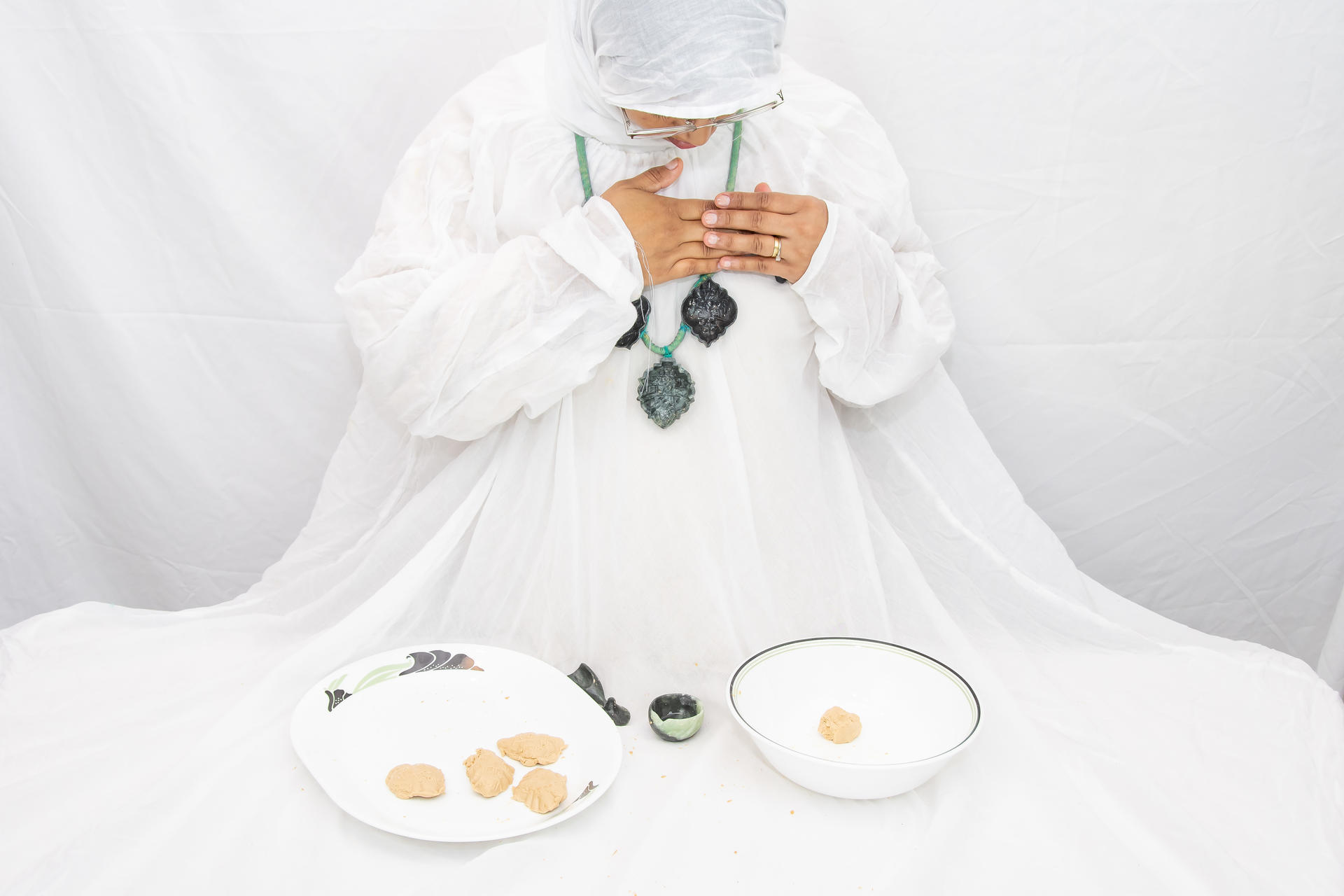
Image from the performance Shondesh Kon Desh? where I wear a garment that extends me over the table while wearing Untie The Knot From My Tongue, pressing shondesh into the necklace.
Video file
Clip from the performance Shondesh Kon Desh? where I wear a garment that extends me over the table while wearing I’m Remembering, pressing shondesh into the necklace.
Flowing over
I chafe against the labels of identity and their relationship to the politics of representation. In many ways, the way I perceive labels of identity is akin to a mold, a hard, resistant, sturdy fixture against which I must conform. It is not the actual labels of identity, per se, that bother me but rather the way I feel essentialized by that label in a society that seems to value outer markers of representation over true depth of experience. To expand the feeling of home, I must “over flow and flow over.” [12]
With the weight of a carved marble plate where the pattern from the Corelle Black Orchid is pierced away, I extrude shondesh from beneath the plate. It fills and overflows the negative spaces cut into the marble, extending beyond even my pattern of home.
Against the mold, I can soften and release. I can extend beyond the nostalgia that tints the safety and security of the spaces and ideas I feel at ease within. I remind myself that only through the synesthesia that is taste can I grasp both my wholeness and inseparability.
[12]Sara Ahmed, Queer Phenomenology, 11.
Image
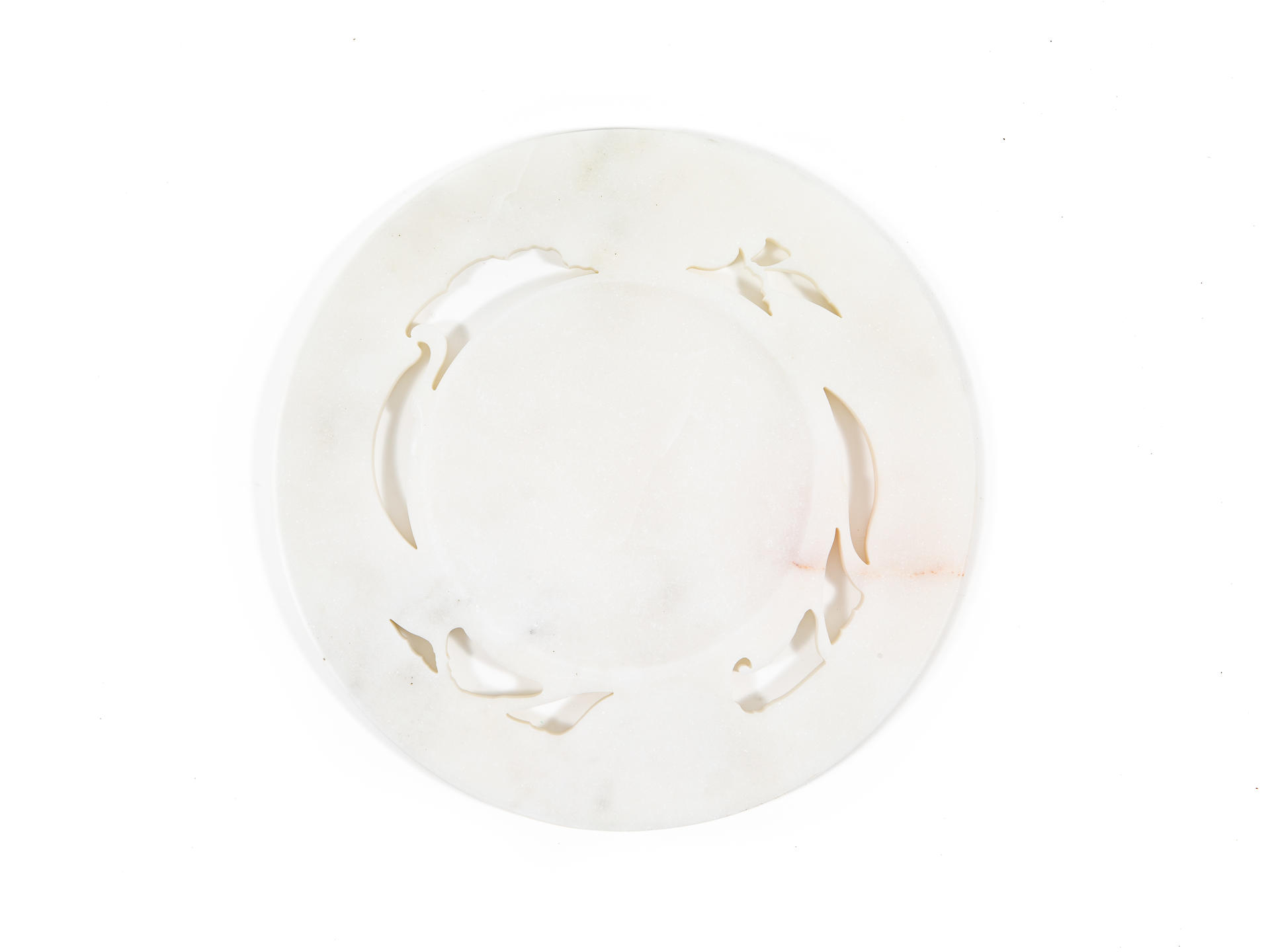
Over Flowing and Flowing Over, a carved marble plate with the pattern from the Corelle Black Orchid plate pierced out of the marble.
Image
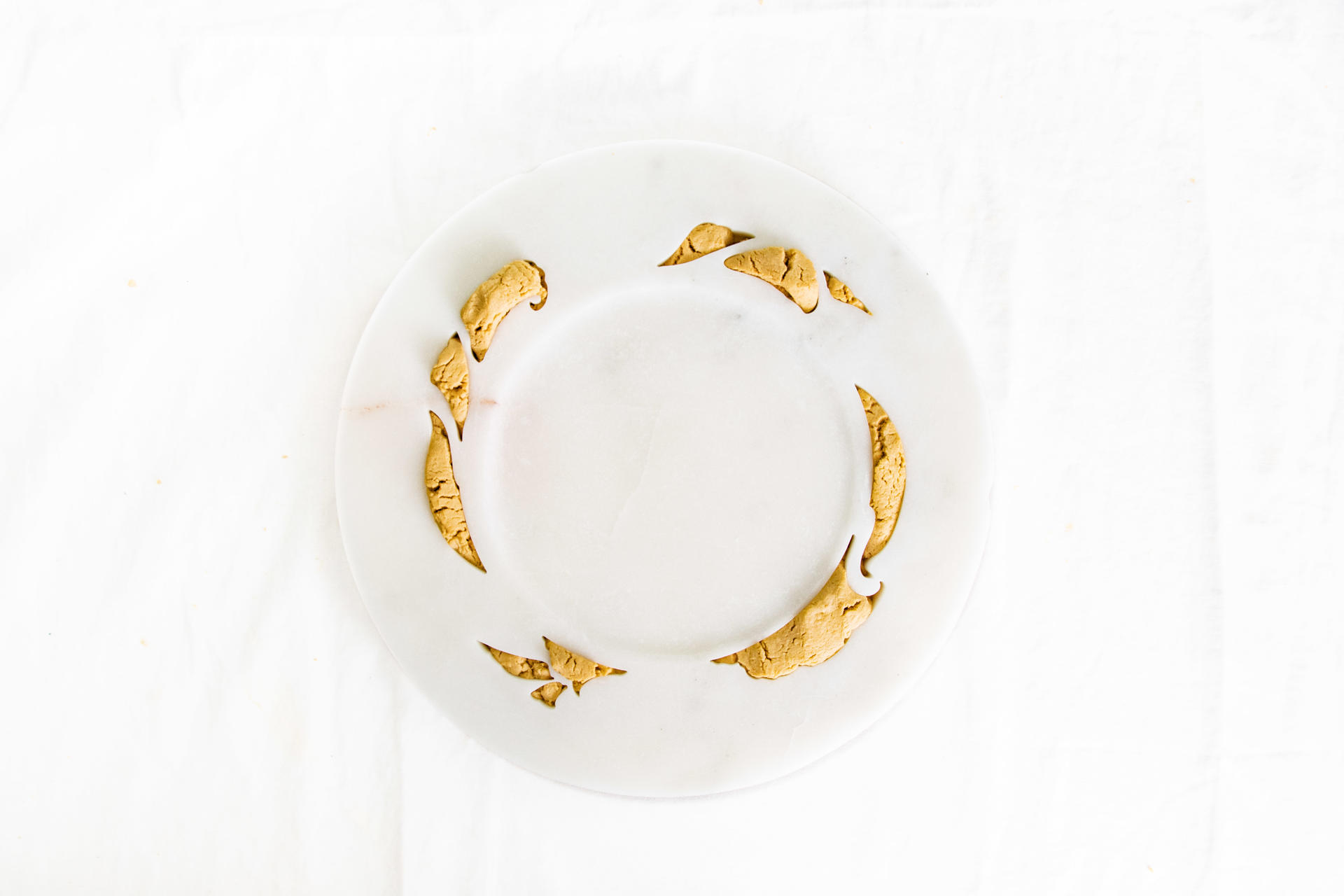
Over Flowing and Flowing Over, once shondesh has been extruded from beneath the plate through the Corelle Black Orchid pattern.
